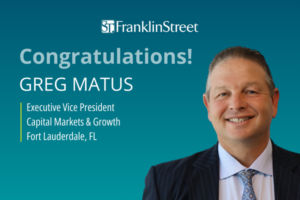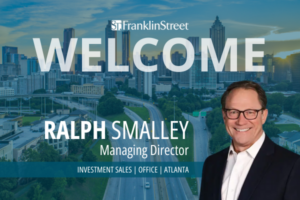For corporations, monetizing real estate through sale-leasebacks is still a useful option. Find out how strategies are changing and why experts predict an uptick on SLBs in 2014.
State Farm Insurance is serious about unlicking corporate real estate value. The Fortune 500 company sold 24 facilities last November alone – and leased them back at a cost of $750.1 million. The leading home and care insurer expected to post a $397.1-million net gain on the deal.
State Farm is not alone. More corporations are turning to sale-leasebacks – a form of financing that allows business owners to maximize the value of real estate assets – as an alternative for managing and financing the buildings they occupy. The upside – from unlocking the full value of the asset in a cash equivalent, to lease structures that qualify as operating leases so the expense stays off the company’s balance sheet, to optimizing lease payments to keep rents lower – is too appealing for many corporate real estate users to pass up in the current economy.
Although sale-leasebacks aren’t right for every company – and although Mesirow Financial predicts market activity to remain flat this year – billions of dollars worth of sale-leaseback transactions will close in 2014. Sale-leaseback strategies may change and challenges are sure to arise, but industry watchers expect to see many corporations explore the possibilities of unlocking real estate value in what is still historically a low-interest rate and low cap rate environment.
“For companies with real assets that are linked to their long-term business strategies, a sale-leaseback can provide a source of long-term capital that allows them to redeploy the value of that real estate in their core business,” says Jason Fox, managing director and co-head of Global Investments at W.P. Carey, a REI specializing in corporate sale-leaseback financing, build-to-suit financing and the acquisition of single-tenant net-lease properties. The company announced record 2013 total investment volume at about $1.8 billion. “By selling a corporate facility to a long-term sale-leaseback investor, a company can retain operating control over the property while accessing the liquidity embedded in the asset.”
Why Sale-Leaseback Deals Are Still White Hot
Before we can look forward, we need to look back. Sale-leaseback strategies have been one of the most consistent alternative financing methods in the 21st century, catching fire during the downturn when traditional financing was hard to come by and staying white hot through the recovery. With cap rates remaining low and interest rates slightly ticking up, the popularity of sale-leasebacks seem to have bona fide staying power.
“Sale-leasebacks are always a useful option for corporations,” says Mac McCall a regional partner with Franklin Street Real Estate Services in Atlanta. “Traditionally, corporations like to invest in their business as it should produce double digit returns versus real estate, which really only appreciates nominally on a yearly basis. By free up the equity tied up in their bricks and mortar they can reinvest in their businesses, pay down debt and clean up their balance sheets.”
David Sobelman, an executive vice president in net lease specialist Calkain Cos.’ Tampa office, has seen sale-leaseback activity increase in 2013 and 2014. But the motivating factors are different today than they were in 2007-2008. During the downturn, companies were desperate to find cash. Banks stopped lending. Operations percentages were down. Selling the real estate and leasing it back unlocked value that helped some companies survive the storm.
“Today, companies with healthy balance sheets are considering sale-leasebacks – and that’s smart because one of the investment criteria is the credit worthiness of the company,” Sobelman says. “The value of the property is much lower when the company’s credit is not good. Strong-performing companies are now in a position to truly minimize the value of their real estate – and many are making that decision.”
The bottom line: As the bond process begin to tick up again, sale-leasebacks are still an important financing tool for corporations, says Ziad Hammondi, a partner in the Global Real Estate practice group in the New York office of Reed Smith. He says there are “very few mechanisms” that would allow a company to leverage 100% of its assets while still being able to take advantage of creating accounting treatment.
Camille Renshaw, a director at Stan Johnson Co., says corporations typically lock up a great deal of equity in real estate at returns that don’t match that of its core business. “For example, a medical group might be getting 8% returns on its real estate, but achieving 40% returns on equity in its core business,” she says. “If the same medical group could access the equity in its real estate and reinvest in its core business – by buying competing practices, investing in new modalities, expanding its physician and client base, etc. – its returns would dramatically increase.”
Post-Recession Sale-Leaseback Strategies Defined
So the motivations have change, but what about the strategies? Although strategies still vary depending on the company’s unique situation, there is more competition for quality transactions. That competition is driving creativity.
“ A combination of both a sale-leaseback strategy and a typical corporate financing strategy is important,” Hammondi says. “However, ultimately this will depend on the cycle point at which your business is in. For example, a sale-leaseback strategy may not be as important to an established company with a strong credit rating that can borrow cheaply in the bond markets or by utilizing its own shares. On the other hand, a growth company or a business who has expensive leverage that needs to reposition its balance sheet would find a sale-leaseback very enticing.”
McCall recommends sale-leasebacks to clients that have growing businesses but may not be able to tap into the bond markets for cheap debt or access favorable leverage from traditional banks. He says smaller operators are attracted to the sale-leaseback because they can control the terms of the leases and in many cases can avoid personal guarantees.
“If companies are cash heavy they may not need any more money and are happy owning their real estate,” McCall says. “Also, some tenants, like grocery stores, want to remain at a site forever so they elect to own their dirt and never have to worry about their lease expiring.”
As Ankur Gupta, a partner in the Chicago offices of McDermott Will & Emery’s Corporate Advisory Group, sees it, companies that sell goods or services frequently lack in-house real estate expertise and, as a result, fail to maximize the value of their owned real estate assets. “Often when examining their various alternatives with expert assistance,” he says,” companies conclude that monetizing their owned real estate assets provides them with a cost-effective and low risk source of liquidity compared to available corporate credit facilities, a bond issuance or a conventional mortgage refinancing.”
Learning From Successful Sale-Leaseback Deals
Successful sale-leaseback deals aren’t difficult to find. Sobelman describes a private equity firm client that owns a continuing education company. Doctors get credit for attending educational conferences at the company’s building in Tampa.
“Our client built the building based on the specific needs of its operation – it was a mission critical facility for them,” Sobelman says. “The company was performing strong and wanted to expand its operations. Instead of going to the bank for a loan, it decided to maximize the value of the real estate by selling and locking in a long-term leasing rate. These types of deals are successful because they open up new revenue streams for companies without interest.”
Beyond State Farm, WPC’s Fox cites Kraft Foods Group, North America’s Fourth largest consumer packaged food and beverage company, as an example. Kraft launched as a public and independent company on Oct. 1, 2012. Subsequently, the company was looking to redeploy illiquid capital tied up in its real estate into its core business. “In 2013 W.P. Carey acquired Kraft’s 70-acre corporate headquarters campus in Northfield, IL for $72 million and leased the 679,000-square-foot facility back to Kraft on a long-term triple net basis,” Fox says. “Kraft has used the proceeds to fund the growth of its business.”
McCall recently worked with a restaurant group in Atlanta that was performing strongly on a per-unit level. But during the economic downturn, he explains, the group expanded too quickly and had too much debt to continue growth. “We completed a sale-leaseback for the company,” he says. “We were able to pay its old lenders off, improve its balance sheet and work with more proactive lenders.”
Ankur offers yet another spin on successful sale-leasebacks. A serviced-based company concluded that monetizing its national portfolio of owned industrial real estate assets would offer a cost-effective and low-risk source of liquidity compared to its available corporate credit facility, a bond issuance or a conventional mortgage re-financing. The company entered into a portfolio sale-leaseback with an industrial REIT, structuring leases that offered flexibility in light of projected long-and short-term growth, ash flow needs and geographic expansion, contraction or diversification.
“The company obtained approximately $100 million of working capital proceeds from the transaction, which it subsequently used to fund a sizeable corporate acquisition and modernize its existing operations,” Akur says. “Absent the portfolio sale-leaseback, the company would have been unable to fund the corporate acquisition due to insufficient equity required to consummate the transaction and would not have been able to cost-effectively and simultaneously modernize its existing operations.”
Renshaw has a prime example of her own: At the beginning of the recovery, American Forest Products, Home Depot’s largest wood supplier, was asked to expand its offerings to clients and take on more home improvement stores. “This was an incredible new business opportunity, but AFP needed more equity to capitalize on the opportunity,” she explains. “Stan Johnson conducted a sale-leaseback across five properties, giving AFP access to capital that was previously locked up in its real estate. With that equity, AFP expanded its credit revolvers, took on new business, hired more employees, and grew its corporation’s EBITDAR immensely.”
Overcoming Sale-Leaseback Challenges
For all the upside in the sale-leaseback world, there are potential challenges to overcome. For starters, tenants have to be willing to cede some control over what can be done at the property without consent of the sale-leaseback finance company, says Joseph Marger, a partner in the New York office of Reed Smith.
“This is no different than what would happen with a mortgage,” Marger says. “Yet sale-leaseback finance companies tend to be long-term holders and relationship-drive, so they are often more responsive to tenant needs than lenders, particularly servicers in the CMBS market. Also, the tenant needs to be willing to part with the property at the end of the term – but many tenants secure Fair Market Value repurchase options to keep ultimate control of the asset.”
Renshaw says buyers are looking for a deep understanding of the corporation, its business plan, its key personnel, its competition and so on – as though it was an equity investor, not a real estate investor. Her experience tells her the strongest buyer pool will find the value of the real estate to be secondary to the future of the corporation and its core business.
“Effectively communicating a company’s business plan within the current sale-leaseback market can be challenging,” Renshaw says.. “Experienced brokers and advisors will develop materials that are easily digested by the buyers’ investment committees, communicating the firm’s past and future in the best light, given market trends and needs.”
The Sale-Leaseback Outlook
Although some industry watchers say sale-leaseback transactions will be flat in 2014, many predict continued momentum, especially if there is a rise in interest rates applicable to corporate credit facilities and if the trend of increased foreign investment in the United State real estate markets continues.
“A rise in interest rates applicable to corporate credit facilities would serve to stimulate companies to examine more cost-effective alternate sources of capital,” Ankur says. “Continuing foreign investment in the US real estate markets would drive more competition into the real estate marketplace, allowing companies to maximize the liquidity available by monetizing their owned real estate and/or ensuring that their lease instrument provides them with the flexibility to facilitate their objectives.”
Hammondi agrees. He sees more sale-leaseback opportunities if bond rates and other financing rates become more expensive. While liquidity has improved since the downturn, the move away from SLBs was predicated on low rates. “As most economists expect rates to shift, we can expect a slight uptick in sale-leasebacks,” he says. “The million-dollar question is: when will the divergence between current financing rates and sale-leaseback cap rates occur to once again make sale-leasebacks a more valuable financing tool for businesses?”
WPC’s Fox says the consensus is that interest rates will grow over time. And with anticipated economic growth and the trend of some manufacturing moving back to the US, he predicts companies will have the need to expand and invest in new facilities. The net-net: WPC sees the demand for sale-leasebacks driven by the desire of companies to lock in lower lease rates while interest rates remain low and also by their need to invest in new and expanded facilities.
Sobelman expects to see some of the lowest cap rates in history in 2014 – and he’s advising clients who have ever considered a sale-leaseback opportunity to move now in response to the lack of inventory on the market. He predicts a continued increase in investor demand for sale-leaseback transactions and suggests companies can get top dollar for their real estate assets.
“Sale-leasebacks make more sense than bank loans,” Sobelman says. “With a sale-leaseback you’re monetizing 100% of the value of your property. There’s no down payment to the lender, so you keep that money in your pocket. That could be tens of millions or hundreds of millions of dollars.”
“Corporations like to invest in their business as it should produce double-digit returns versus real estate, which only appreciates nominally on a yearly basis.” – Mac McCall, Franklin Street Real Estate Services. Download PDF



